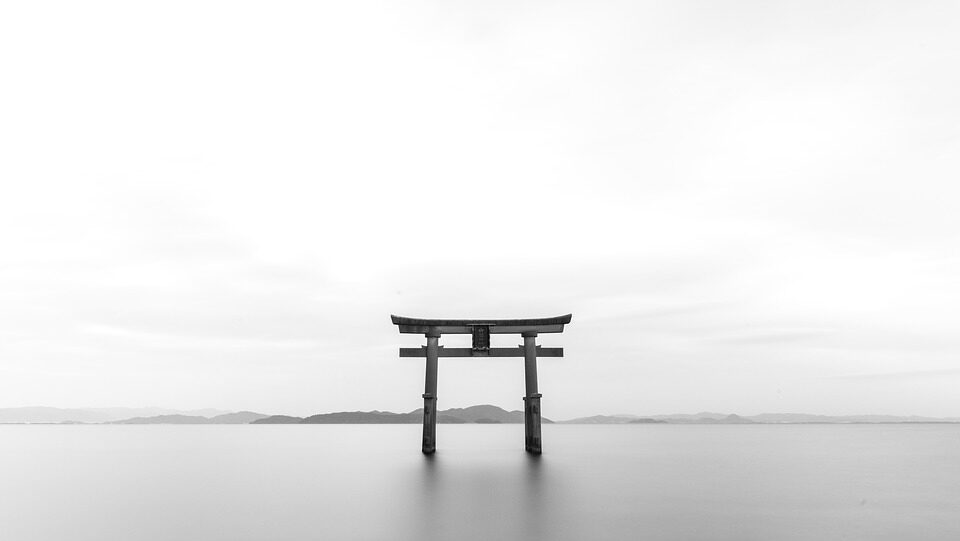【Kimono Culture】Understanding the Japanese coming-of-age ceremony “Seizin-shiki(成人式)”
In this page, I will write about a familiar event in Japan, the coming-of-age ceremony.
It is called “Seizin-shiki(成人式)” in Japan.
It’s one of the few events in Japan today where many of the participating adults wear kimonos.
It is an event that everyone experiences in Japan, but it may be seen as a rarity in other countries.
Here’s an introduction, along with some kimono culture!
目次
What is the “coming-of-age ceremony”, where kimono culture is alive and well?
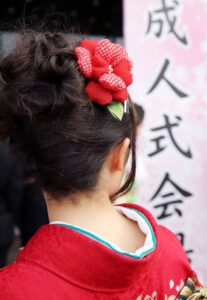
It is an event held in various regions of Japan to congratulate and encourage those who will become adults (18 years of age) during the fiscal year (April to March).
Women often wear kimonos, and men wear traditional formal attire called Montsuki Hakama(紋付袴).
It is a natural event in Japan, but may be unusual for people from overseas.
In Japan, this is a natural event, but from a foreign point of view, it may be a rarity, as it is rare for an entire country to celebrate coming of age.
It is held on the second Monday of January of each year at a location determined by each local government.
In Urayasu City(浦安市), Chiba Prefecture, a famous example is held at Disneyland as a regular event.
In some local governments, the ceremony is held on a day other than Coming of age day.
The Roots of the “Coming of Age Ceremony”
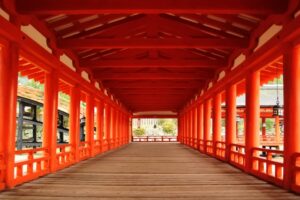
In Japan, we have the term “Kan-kon-sou-sai(冠婚葬祭)”, and the coming of age ceremony is the first “Kan(冠, This word means “crown”)”.
This alone shows how important the coming of age ceremony has been.
There have been coming of age rituals in Japan since ancient times.
Let’s take a look at some of the representative ones.
“Genpuku(元服)” is a ritual of passage for men
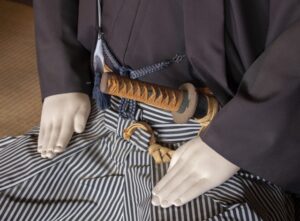
From the Nara period (奈良時代, 710-794) onward, boys between the ages of twelve and sixteen began to undergo a ritual of passage called “Genpuku(元服)”.
They tied their hair into an adult hairstyle, changed their clothes, and received a crown from their crown-granting parents(冠親).
In the samurai family, it was normal for a man to be given a Eboshi(烏帽子) by Eboshi parents and to change his name.
In the case of noble families and samurai families of the Taira clan(平氏), heavy makeup, Ohaguro(お歯黒, black teeth), and Hikimayu(引眉, eyebrows) were also applied.
From the Muromachi period (室町時代, 1336-1573), the ceremony spread to the private sector, and since there was no age limit, it was widely practiced from 5 or 6 to 20 years old.
From the Edo period (江戸時代, 1603-1868), the ceremony was simplified, and samurai families and commoners began to do it without a Eboshi, without bangs, and with only a shave of the Sakayaki(月代).
From the Edo period onward, women also changed their hairstyle and clothing when they got married, or when they were 18 to 20 years old, and sometimes wore heavy makeup, Ohaguro(お歯黒, black teeth), and Hikimayu(引眉, eyebrows).
Rituals for noblewomen “Mogi(裳着)”
From the Heian to Azuchi-Momoyama periods, court ladies had a ritual called “Mogi(裳着)”.
It was a ritual to put on a garment called a “Mo(裳)” that was wrapped around the waist and below.
The ceremony was held when the couple was between the ages of 12 and 16 and when they were about to get married.
They were allowed to marry by performing the “Mogi”.
At the same time, a ceremony was held to tie up the hair, changing it from a drooping child’s hairstyle to an adult’s hairstyle.
Coming of Age Rituals of the Common People in the Past
The ceremony of “Genpuku” or “Mogi” was generally reserved for the upper class, such as samurai and noble families, while the common people had a different ceremony.
There were different rituals for the common people, which differed from village to village and from area to area.
For example,
“They will be able to carry a sack of rice by myself.”
“To be able to hunt wild animals such as deer by themselves.”
The most famous of these is the “Hundoshi-iwai (褌祝, Loincloth Celebration)”, which seems to have been held in many areas.
A loincloth(Hundoshi) is a belt-like underwear worn by Japanese men in the past.
As the name suggests, the loincloth Hundoshi-iwai is a ceremony in which a loincloth is given to a child around the age of 13, as a sign of recognition from a female relative that the child has become a full-fledged adult.
When did the coming of age ceremony in its current form begin?
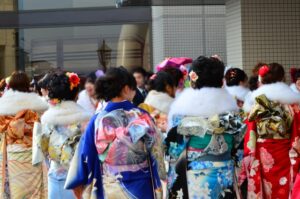
It is said that the first coming of age ceremony in its current form was the “Seinen-sai(青年祭, Youth Festival)” held in 1946 in Warabi City(蕨市), Saitama Prefecture.
In 1946, a year after the end of the Pacific War, the world was in turmoil and anxiety, and the Warabi-machi Youth League in Warabi City took the lead in encouraging the young people who would carry the future.
During the “Seinen-sai(Youth Festival)”, a “Coming of Age Ceremony” was held.
The event attracted the attention of the prefecture and the national government and spread, and in 1949, January 15th was designated as “Coming of Age Day”.
The reason why it was set on January 15 was because it was customary to hold the “Genpuku”, a ritual of passage, on the first full moon of the new year.
(However, that was in the lunar calendar, so January 15 is not necessarily the full moon in the current calendar.)
Later, with the revision of the National Holiday Law in 2000, “Coming of Age Day” was changed to the second Monday of January due to the Happy Monday system to increase the number of three-day weekends.
What kind of ceremony is the coming of age ceremony?
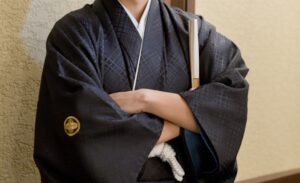
Each local government gathers at a different location where a large number of people can attend, and lectures and mementoes are given.
Usually, the mayor speaks on the stage, and depending on the local government, a celebrity from the local area may attend as a guest or send a message.
In addition, the day of the ceremony is often like a reunion, as you get to see friends you haven’t seen in a long time due to different schools.
After-parties are held in each area, and sometimes teachers from schools in that area participate.
The location of the after party can be a party venue or a bar in a rough environment.
What kind of clothes will they wear?
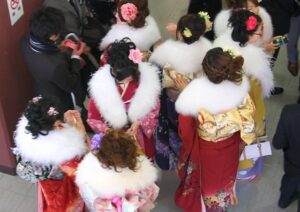
When it comes to coming of age ceremonies, the first thing that comes to mind is the clothing.
The overwhelming majority of women wear a kimono called “Furisode(振袖)”, which is said to account for about 90% of all kimonos.
“Furisode” is considered to be the most prestigious type of kimono for unmarried women, and is characterized by its longer sleeves than other types of kimono.
It has many gorgeous and youthful patterns, and has now become an established costume for the big day of one’s life.
While some families have purchased Furisode and passed it down through generations, more and more people are now using rental costumes.
Many people make appointments at beauty salons for dressing, hair and makeup, and it has become a tradition at the beginning of each year that beauty salons are busy from early in the morning on the coming of age day.
As for Furisode, the most popular patterns and designs are often decided early, so it is normal to start making reservations and other preparations about two to three years in advance.
Men generally wear suits or “Montsuki-Hakama”.
As with women, men are increasingly renting Montsuki-Hakama.
Current Coming of Age Ceremony
Moral decline
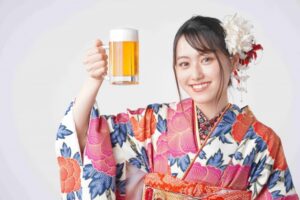
Every year there have been reports of newcomers dressed in kimonos loudly and excitedly disrupting the ceremony itself during the ceremony, or getting drunk on alcoholic beverages and running amok in the streets.
Some of them were even arrested for obstruction of public order, a phenomenon that reveals the decline in morals among young people in what is supposed to be an occasion to renew their commitment to adulthood.
lowering the age of adulthood
In 2022, the Civil Code was amended to lower the age of adulthood from 20 to 18.
When the age was first lowered, there seemed to be some issues regarding the age of those eligible to participate, but from 2024, the age has been unified to 18-year-old adults.
Since 18-year-olds are not allowed to drink alcoholic beverages, it may be difficult for them to act out of control.
Thoughts on the Coming of Age Ceremony
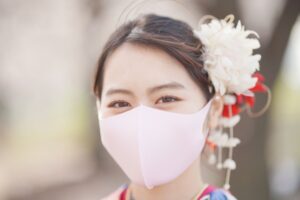
I am now in my thirties, but I remember my own coming-of-age ceremony well.
The ceremony I attended in my hometown was not a riotous one, nor was it held in a special place, nor did it have famous guests.
Nevertheless, I vividly remember seeing my classmates after a long time and having a special ceremony as a new adult.
At the time, I think it was just a reunion, but now that more than ten years have passed, I feel that my value has gradually grown as I was able to participate in a ceremony that inherited Japanese culture.
It is sad that the only opportunity for many people to wear kimono is this coming of age ceremony, but I do not want this culture to disappear.
For me, it is one of the Japanese cultural events that I would like to cherish.
